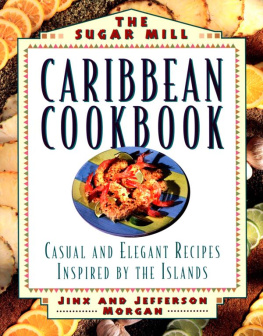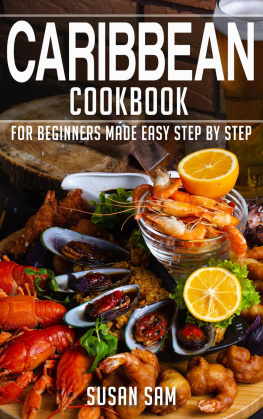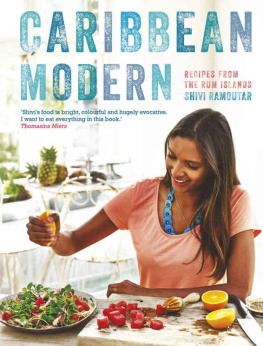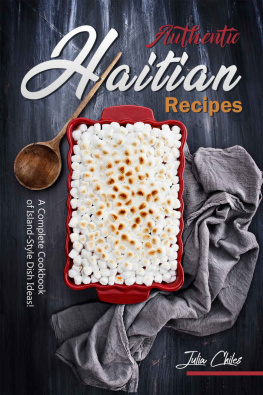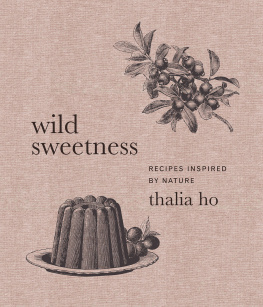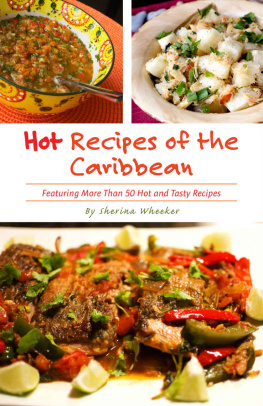T HE H ARVARD C OMMON P RESS
535 Albany Street
Boston, Massachusetts 02118
Copyright 1996 by The Morgan Corporation, Ltd.
Illustrations copyright 1996 by Dorothy Reinhardt
All rights reserved.
No part of this publication may be reproduced or transmitted
in any form or by any means, electronic or mechanical,
including photocopy, recording, or any information storage or retrieval system,
without permission in writing from the publisher.
Printed in the United States of America
Library of Congress Cataloging-in-Publication Data
Morgan, Jinx.
The Sugar Mill Caribbean cookbook : casual and elegant recipes
inspired by the Islands / Jinx and Jefferson Morgan,
p. cm.
Includes index.
ISBN 1-55832-120-9.ISBN 1-55832-121-7 (pbk.)
1. Cookery, Caribbean. 2. Sugar Mill Hotel (Road Town, V.I.)
1. Morgan, Jefferson. II. Title.
TX716.A1M6697 1996
641.59'1729dc20 96-9929
Cover and text design by Kathleen Herlihy-Paoli, Inkstone Design
Cover photographs by Roberto Santos/Southern Stock (border) and
Peter Johansky/Envision (center)
Illustrations by Dorothy Reinhardt
Special bulk-order discounts are available on this and other Harvard Common Press books.
Companies and organizations may purchase books for premiums or for resale,
or may arrange a custom edition, by contacting the Marketing Director at the address above.
10 9 8 7 6
This book is dedicated
to the people of the British Virgin Islands,
who welcomed two strangers from far away
and made us feel right at home.
Acknowledgments
In the fifteen years we've lived in the British Virgin Islands dozens of people have befriended us, offered us wise advice, shared their picnics, fed our cats, helped us clean up after storms, sailed us to their secret harbors, let; taught us how to clean a conch, and generously passed along their knowledge of Caribbean ingredients and cooking techniques. In the process they also set a standard for friendship that would be hard to duplicate. They all know who they are and we give them our deepest thanks.
Our thanks also to a great lineup of chefs, including Rick Buttafuso, Ivor Peters, Jeff Oakley, Chris Griffiths, and Mona Donovan, who, over the years, helped make the Sugar Mill a special place to dine and contributed much to this book.
We're grateful to Cheryl and Bill Jamison, who gave us a push in the right direction, and to Belle and Barney Rhodes, who were there at the beginning to support us in a most tangible way.
We salute our editors at Bon Apptit, especially Bill Garry and Barbara Fairchild, for sticking with us for all these years and sending us to all corners of the Caribbean on delicious voyages of discovery.
A good editor is to writers what a sturdy net is to high-wire performers. Linda Ziedrich is one of the best, combining sensitivity and precision in just the right balance. Dan Rosenberg's enthusiasm and hard work guided the project from the beginning, and Dorothy Reinhardt's illustrations add charm and style to the book.
We thank Carl Brandt, as always, both agent and friend. Carl also has fallen prey to the wacky lure of paradise, and now, during our favorite part of the year, he and his wife Clare are fellow residents of Tortola.
The staff of the Sugar Mill has shouldered a bigger load than usual to give us the time to complete this book, and we are most appreciative of that. A special thanks is owed to our General Manager, Patrick Conway, who leads the team, and Assistant Manager Joanna Samuels-Watson, who keeps us all sane.

Introduction: A Caribbean Cooking Adventure
Like romantics everywhere, we are always at the mercy of our fantasies. At no time was this more evident than one starry night more than a dozen years ago when we walked into a hotel and restaurant in a beautiful old stone building on the Caribbean island of Tortola and fell head over heels into the craziest period of our lives.
The place was for sale.
And so began our Caribbean saga, an adventure that took us from our home in California to a new life as owners of a small hotel and restaurant in the British Virgin Islands. From the first it was a madcap scheme, since we were neither seasoned hoteliers nor restaurateurs. As writers specializing in food and wine, we had traveled the world and stayed at a variety of hotels, but that experience qualified us for owning a hotel in much the same way that being frequent flyers would qualify us to handle the controls of a DC-10.
It didn't take us long to realize that it would take hard work and an abiding sense of humor to fulfill our dream of creating a special small resort with a certain style and a soupon of elegance; in other words, the sort of hotel we liked to stay in when we traveled.
Fortunately, the Sugar Mill itself gave us a head start toward our dream. The hotel is built on the site of the old Appleby Plantation, from which Tortola's Apple Bay gets its name. Only a small, crumbling wall remains of the Great House, which we suspect was great more in name than in elegance. But the beautiful old stone boiling house, where rum was made, still stands, and it now houses our main restaurant.
The old Sugar Mill has been witness to more than three centuries of Caribbean history. Sometimes on a starlit night, when a breeze blows softly through the candlelit dining room, we think we can almost hear the whispers of those plantation days long ago.
Clearly, however, it would take more than such romantic notions to make the Sugar Mill a success. When we came to Tortola we were long on theory and woefully short on hotel and restaurant experience. We listened, learned, and eventually began to get the hang of things. But, as always in the islands, each day brought a new challenge.
The problem of getting supplies is a complaint that runs up and down the islands, and we were no exception. The ferry that brought us most of our provisions was a leaky lifeline to suppliers, who appeared to see the Sugar Mill as a place where that last crate of antediluvian lettuce might find a home.
Electricity, too, can be a sometimes thing in the West Indies, and equipment such as blenders and food processors have a way of expiring just as the first diners are being seated. The romantic dining room is suddenly plunged into darkness (to say nothing of the chaos that ensues in the kitchen) and guests begin feeling their way through the crowd, often making lifelong friendships along the way. This event is usually followed by the discover that the propane bottle feeding the ranges has run out of gas, and that the lantern batteries appear to be so old and corroded that they might have been salvaged from Truk Lagoon.
It is inevitable that, on an evening when all of the foregoing has taken place, when the cisterns have run dry, and when a group of surfers is in the bar delighting the cocktail crowd with unsavory college drinking songs, the food critic from the New York Times strolls in.
Faced with such new challenges, we did what so many others in the islands have done. We improvised. With more optimism than good sense, we planted a vegetable garden and watched our neighbors shake their heads at our folly in trying to grow herbs and lettuce and mysterious vegetables in the dry and rocky soil we called our own. Eventually, though, the vegetable garden thrived, and tided us over until boats and planes began bringing a wider variety of fresh produce and a couple of new ferries linked us more reliably with overseas suppliers.
However, it was the native ingredients that really intrigued us. What cook could resist the temptation of trees weighted with mangoes, papayas, soursop, sugar apples, guava, coconuts, plantains, bananas, and avocados? We learned to work with local vegetables that we found at Tortola's colorful open-air market, including pumpkins of all shapes and varieties, breadfruit, christophene, a type of spinach that grows on a vine, and "provisions"knobby and strange-looking root crops, including dasheen and taro, that are essential to many local recipes. At the market, too, we found friendly farmers who told us about guavaberry wine and sold us bundles of homegrown parsley, rosemary, thyme, and green onion, tied together and called "seasonings," and explained the incendiary properties of the various peppers they displayed.
Next page
